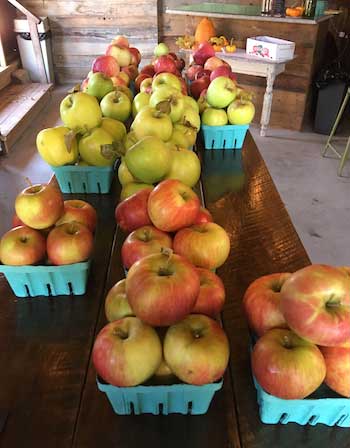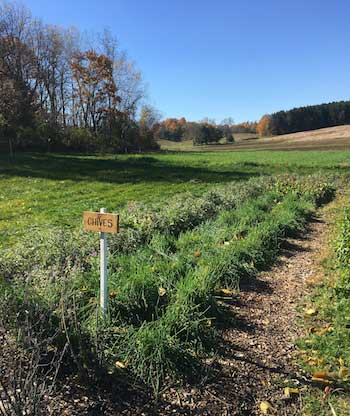Local food movement connects communities, while offering superior taste and nutrients
Farms and restaurants seek better connections for utilizing food grown in the nearby community
(Editor’s Note: Madeline Gibbs of Albion is a senior at the Rochester Institute of Technology, majoring in Dietetics & Nutrition. This report follows a study on local foods, including interviews with farms and restaurant owners.)
Guest article by Madeline Gibbs

Photos courtesy of Madeline Gibbs: Madeline Gibbs is pictured at the Ithaca Farmers’ Market.
During the summer of 2018 I had the privilege to get my hands dirty and experience what it’s like to be a farmer at Kirby’s Farm Market, a family-owned and operated farm located on Ridge Road in Brockport.
The experience truly was life-changing, and by far, the best and most-rewarding job I’ve had to date; it also led me to pursue research on the local food movement—to assess what local really means for farmers and restaurants that source locally, as well as what it entails for our health, communities, economy…our world.
My findings revealed the transition from a more global to local market brings people together and the primary reason restaurateurs source locally is for the high quality, superior taste, and freshness—yes—but more importantly because they desire a connection with where their food came from and a connection with who grew it. I experienced how rewarding this connection is by working on a farm myself.
The new trending area in the restaurant industry is “farm to table” and sourcing locally, as more and more consumers become health conscious and desire to have a connection with growers and food. Being one of those consumers myself and living in Rochester where I have the luxury of local food around me through places such as Brighton Farmer’s Market and Public Market, I tend to shop locally the majority of the time and still go to Farmer’s Markets even in the winter.
As consumers are increasingly interested in where their food comes from, more restaurants are embracing local food and connecting with farmers. The COVID-19 pandemic has resulted in concerns about where to buy food as supermarkets struggle to keep up with demand; local farmers and food hubs may ensure community food resilience.

Working on a local farm, I felt this definition didn’t accurately encompass all that local food is. It turns out, the participants of my study had differing beliefs as well. Ten local farmers, and restaurateurs and chefs that source from local farms, participated in my study, allowing me to conduct one-on-one interviews with them. Questions addressed defining local, impacts that sourcing locally has, what it means to effectively source local in a restaurant, the infrastructure needed to see more restaurants go farm to table, etc.
Several themes were apparent in the interviews where participants were asked to define local. Relationships with farmers, being within one’s neighborhood or county, geographical distance, and proximity were all contributing factors in what local meant to restaurateurs, chefs, and farmers, but the most pertinent themes revolved around one central idea—that locality primarily meant familiarity to the participants, and furthermore, being a part of one’s community. The primary reason many chefs and restaurateurs sourced locally was to support their neighbors who are farmers and to connect within their communities. Two restaurateurs from fine-dining stated that local is “relationships, it’s very personal” and “the farms we are dealing with are our neighbors,” which further emphasizes the connection-based definition for local food. Quality, freshness, taste, and nutritional attributes were also a main focus of the results.
Small-scale production is a valuable aspect of the local food movement, but additional funds for local, small-scale farmers may help them reach more consumers and effectively provide to the restaurant industry.
Farmers, as well as restaurateurs and chefs, agreed that local food is better in quality and taste, and higher in nutrient content. Not only was eating with the seasons considered healthful, but consuming food soon after it has been harvested was also associated with higher nutrient content by chefs and restaurateurs. Chefs believed that local food is of better quality, of higher value, fresher, more flavorful, and easier to work with. Furthermore, local food was said to be more sustainable and better for the environment.

The second finding revealed that local food is multifactorial, and its attributes go beyond just its definition. Local food has positive physical and sensory attributes, but there is also a perceived personal benefit of local sourcing that reverts to social connectedness. Restaurateurs, chefs, and farmers did not purchase local food for reasons solely dependent on consumer demand or trendiness, they support local sourcing because of personal values associated with the local food movement. Participants felt it was a rewarding act to buy local food and appreciated the restaurateur-farmer relationships that were formed.
While local food has many perceived benefits, that doesn’t come without barriers. For example, livestock farmers could benefit from more restaurants undertaking a nose-to-tail approach. Greater transparency can improve success of sourcing locally.
Policy initiatives to better assist local farmers should also be investigated. For example, meat producers struggle finding small USDA inspected slaughter houses and local butchers are limited in number, by implementing changes in this area, farmers may have less expensive butcher bills and be able to use that money in other areas of their farm.
Small-scale production is a valuable aspect of the local food movement, but additional funds for local, small-scale farmers may help them reach more consumers and effectively provide to the restaurant industry.
Strengthening community, collaboration, and local relationships were themes related to local food that proved to be of greater importance than the definition of local food itself. Thus, local food should be regarded as a pathway for bringing communities together, appreciating what agriculture a region has to offer, and providing a deep connection with not only who grew the food, but food itself.


































































